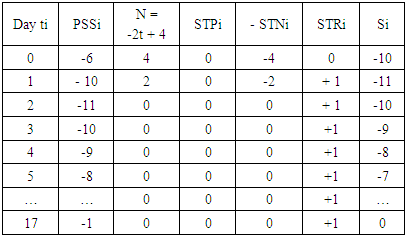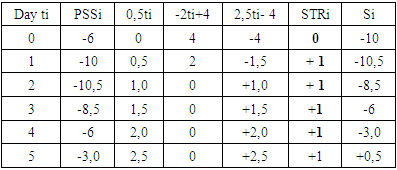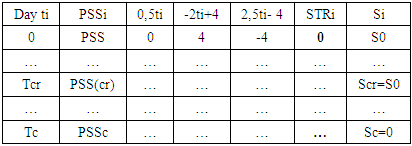-
Paper Information
- Paper Submission
-
Journal Information
- About This Journal
- Editorial Board
- Current Issue
- Archive
- Author Guidelines
- Contact Us
International Journal of Applied Psychology
p-ISSN: 2168-5010 e-ISSN: 2168-5029
2018; 8(2): 30-39
doi:10.5923/j.ijap.20180802.03

A Mathematical Evidence of the Therapeutic Effect of Relaxation
Ktiri Fouad
Psychology Department, Institute of Nursing professions and Health Techniques, Rabat, Morocco
Correspondence to: Ktiri Fouad, Psychology Department, Institute of Nursing professions and Health Techniques, Rabat, Morocco.
| Email: |  |
Copyright © 2018 The Author(s). Published by Scientific & Academic Publishing.
This work is licensed under the Creative Commons Attribution International License (CC BY).
http://creativecommons.org/licenses/by/4.0/

In this paper we present a mathematical proof of the positive effects of relaxation therapy. We mathematically demonstrate that relaxation, practiced during a period of days, could relieve stress and even make us feel joyful. Based on our tri-transactional theory of stress [1], our demonstration uses the Ktiri-stress equation (S = PSS + ST) and the positive-negative stimuli notions. Our evidence of the positive effect of relaxation is based on the psychological fact that this therapy generates positive and reduces negative stimuli numbers. This phenomenon, meaning that a person practicing it will be able over time to be exposed to more positive and less negative stimuli, is mathematically expressed by using increasing and decreasing mathematical functions (x = at + b). This demonstration is applied to an example of a stress situation in which a person, supposed so much stressed, is much less exposed to positive stimuli which could fight his stress, and much more to negative stimuli. From this demonstration, which was possible by using mathematical notions, we deduced and developed mathematically two concepts. These latter, we called crisis and critical stress periods, correspond to intervals of time at the end of which the value of a person stress state starts to be reduced and to become neutral respectively. The importance of this study lies in the possibility to use mathematics in psychotherapy. Before doing any empirical researches to verify the effectiveness of a new proposed technique, researchers should check if they could also mathematically demonstrate its therapeutic effect. This study proves another time that psychology could cohabit with mathematics.
Keywords: Stress, Relaxation, Ktiri-Stress formula, Positive stimulus, Negative stimulus, Mathematical increasing function, Mathematical decreasing function, Crisis stress period, Critical stress period
Cite this paper: Ktiri Fouad, A Mathematical Evidence of the Therapeutic Effect of Relaxation, International Journal of Applied Psychology, Vol. 8 No. 2, 2018, pp. 30-39. doi: 10.5923/j.ijap.20180802.03.
Article Outline
1. Introduction
- In order to reduce the detrimental effects of stress, many mind-body methods can be used [2]. Relaxation therapy is one modality among others. The term “relaxation therapy” includes, in fact, a broad range of techniques aimed at relaxing muscles and creating a calm state of mind [3], such as meditation, mindfulness, autogenic training, Tai Chi and so on. Some of them are even easy to practice alone. According to Schultz [4], the autogenic training technique does not require specific skills for a non-intellectual individual to practice by oneself.The positive effects of these techniques have been investigated in numerous researches. They constitute methods used to control anxiety and perceived stress and promote well-being [5, 6, 7]. It has been demonstrated, for example, that both yoga and relaxation, practiced during a period of 10 week interventions, improve stress, anxiety and quality of life [8]. Meditation has been shown to reduce unhealthy effects of stress, especially on immune system [9]. Accompanying chronic illness or daily life, stress has been demonstrated to be reduced by techniques like guided imagery, diaphragmatic breathing, progressive muscle relaxation and cognitive behavioral stress reduction [5]. It has also been found that relaxation techniques could inhibit or reduce neurogenic inflammation [10] and minimize the risk of Posttraumatic Stress Disorder [11]. If these techniques can individually be implemented, some of them could be combined in order to provide more effective outcomes, such as combining diaphragmatic breathing with muscle relaxation exercises [12].While researches, carried out to study and prove the beneficial effects of relaxation techniques, are in general empirical and comparative, our present study, however, is theoretical and uses mathematical notions and equations. Our goal is to mathematically prove that relaxation therapy has a positive impact on stress reduction.Using mathematics in the field of psychology is not new. It has being used for many years in sub-fields such as psychological measurements, psychophysics or generally in experimental psychology [13]. The term “mathematical psychology”, however, has become current only with the appearance of the handbook of Luce and collaborators and, simultaneously, the first issues of the journal of mathematical psychology [13, 14]. It is defined as a method used for investigating psychological phenomenon rather than understanding them [15] or been a domain of application [16]. It expresses psychology theories by using mathematical models [16]. It can be considered as a sub-field of psychology that contributed to theories especially in the cognitive areas such as memory, decision making, learning, attention and problem solving. Some other examples of concepts that have been elaborated by mathematical psychologists are the models of stochastic memory and the foundations of measurement [17]. Some authors have contributed to mathematical psychology by creating mathematical functions. Weber has suggested a mathematical equation, which can determine and predict subjective risk judgments of a person [18]. In the stress area, some theoretical/mathematical models have been developed. In 1985, Osuna developed a mathematical function that calculates the stress caused by waiting situations [19]. Denuit & Genest proposed an extension of this model in in 2001 [20]. In our tri-transactional theory of stress [1] we developed a mathematical formula (S = PSS + ST) that explains the occurrence of stress and assesses its state value of an individual.Mathematics has also been used in psychotherapy area. Fischer proposed a model that allows to assess the effect of a treatment or two and the interactions between them (biofeedback,…) [21]. A computational paradigm, suggested by Molenaar [22], can evaluate and optimize a continuing individual psychotherapeutic process in real time. Nevertheless, to our best knowledge, mathematically demonstrating the positive effects of psychotherapy or any mind-body techniques on individuals has not been provided until now, by a new research in the literature. Our mathematical demonstration of relaxation effects will be based on our new approach theory of stress [1] from which we use ktiri-stress formula (S = PSS + SV + R/ S = PSS + ST) and the positive stimulus notion. A Positive stimulus, according to our numerical approach, is the type of stimulus, which could reduce, fight stress or even make us feel happy.In order to do this demonstration, we will first show that the relaxation therapeutic effect is equivalent to the fact that positive stimuli increase and negative stimuli decrease during a period of relaxation therapy.This demonstration will be applied to an example of a stressful situation under which a person is supposed to be so much stressed that he is daily exposed to only negative stimuli and rarely to positive ones.By mathematically expressing the increase and the decrease of positive and negative stimuli respectively, and using the ktiri-stress equation, we will demonstrate that relaxation has a therapeutic effect after a period of practice.
2. The Tri-transactional Theory of Stress and Stress Evaluation
- Our new approach of stress, to which we give the name “the tri-transactional theory of stress” [1], is a numerical stress model that completes the transactional theory of Lazarus and Folkman [23]. According to it “The internal state of stress (positive or negative), that a person experiences, is the production of the transaction between his/her current state, his/her internal or external environment and the availability of the resource(s) that could fight the threatened stimuli of this environment” (p. 108). To assess the stress state (positive, negative, neutral) of a person, we proposed a mathematical equation which comprises 3 dimensions or parameters (PSS, SV, R) that are necessary to take into account in order to know if stress could occur or not [1]. This equation is:
 | (1) |
 | (2) |
3. A Stress Situation
- During a day, a person can be exposed to negative and/or positive stimuli. The two types of stimuli are completing each other. At the end of the day or just before going to bed, this person will have a quantity of stress S which could be null (no stress), positive (joy) or negative (stress) [1].The same reasoning could be applied to a period (of m days). The positive or negative stimuli to which the person had been exposed are completing each other during this period, and, at the end of this, this person will have a quantity of stress S (positive, negative or neutral). The value of S would be as follows:
 | (3) |
 represents the sum of n values of positive stimuli received during n days of the period.
represents the sum of n values of positive stimuli received during n days of the period.  represents the sum of n values of negative stimuli received during n days of the period.Suppose this person lives under such stressful conditions that he/she is rarely exposed to positive stimuli, which could help him/her fight his/her negative state of stress. Thus, the number of his/her daily positive stimuli are much less than the number of his/her daily negative ones. In other words, much of his/her STPi are null. Consequently, in order to reach a neutral state of stress or even a joyful state of mind, his/her negative and positive stimuli should decrease and increase respectively. To achieve this goal, we propose for this person to practice a relaxation therapy for a period of days. Its positive therapeutic effects in reducing his/her stress will mathematically be demonstrated.
represents the sum of n values of negative stimuli received during n days of the period.Suppose this person lives under such stressful conditions that he/she is rarely exposed to positive stimuli, which could help him/her fight his/her negative state of stress. Thus, the number of his/her daily positive stimuli are much less than the number of his/her daily negative ones. In other words, much of his/her STPi are null. Consequently, in order to reach a neutral state of stress or even a joyful state of mind, his/her negative and positive stimuli should decrease and increase respectively. To achieve this goal, we propose for this person to practice a relaxation therapy for a period of days. Its positive therapeutic effects in reducing his/her stress will mathematically be demonstrated.4. Relaxation as a Therapy
- Having two senses, the word “relaxation” refers either to a global state of rest or to a technique [24]. As a mind-body method, relaxation includes all techniques that allow to get relaxation response [25]. The term “relaxation response”, which was first introduced by Herbert Benson in 1974 [26], is a bodily change, that is a physiological state [27].Considered as opposite to stress response (fight and flight response), the relaxation response is a hypothalamic reaction, which results in decreasing of nervous system activity, respiratory rate, heart rate and metabolism [28]. These bodily changes occur when one experiences profound muscle relaxation [29] and can be generated through meditation, biofeedback and yoga among others [28].In order to achieve a state of a relaxed body, many relaxation techniques could be used. These could be divided into two types: deep relaxation and brief relaxation. The deep techniques (progressive relaxation, autogenic training…) provide an effect of large intensity, where brief techniques aim to obtain an immediate release when the subject is facing stressful events. [24]In terms of how relaxation therapy works, the different techniques could be divided into four kinds: those that reduce muscle tension, those which activate the parasympathetic division of the autonomic nervous system and decrease the physiological arousal, those which draw attention away from the source of stress (imagery,…) and those which help focusing on a specified emotionally neutral object (breathing in meditation) [24].
4.1. Positive Effects of Relaxation
- The positive effects of relaxation have been shown in many studies. On a cognitive level, relaxation can still the mind and make thinking clearer and, on a philosophical level, it increases the awareness of the self. It induces a pleasant sensation and decrease stressful thoughts [24]. Chronic stress reduction and well-being enhancement could also be reached by various mind-body interventions, including relaxation [30]. It was also reported that stress-related symptoms could be countered by eliciting the relaxation response. These include insomnia; diabetes; hypertension; anxiety; rheumatoid arthritis; and aging [30].
4.2. Relaxation as a Positive Stimulus
- According to the tri-transactional theory, relaxation is considered as a positive stimulus. It could reduce the negative state of stress of a person and even create for him/her a state of joy. Its value is positive: ST (relaxation) = +1, +2, +3… [1]. Whitaker and Bushman also consider relaxation as a positive experience which is associated with positive affect (peace, happiness) [31].We suppose that the degree of ST (relaxation) depends on the quality of relaxation that a person could receive during a session. This quality depends, among other features, on the duration of a relaxation session and the number of sessions. A short time (20 mn) of a session cannot be sufficient to reach a good state of relaxation for cancerous patients [32]. Luebbert et al. found that the median of 37,5 mn of a single relaxation is adequate for cancerous patients [33]. The number of relaxation sessions was also found to be correlated with salivary cortisol reduction, that is the intensity of stress [34].
4.3. Relaxation and Its Decreasing Effect on Negative Stimuli Number
- When facing a negative stimulus (noise, fear, work problem, sad scene…), a person could react negatively or neutrally [1] [28], and, therefore, feels stressed out or not. According to our stress approach [1], our previous state of stress influences also the perception of these types of stimuli.By using the Ktiri-stress formula [1], we can demonstrate that relaxation, considered as a positive stimulus, could reduce or fight the state of stress of a previously stressed person (PSS<0):Example:S = PSS + ST = (-1) + (+1) = 0: the person no longer stressedPSS = - 1: the person was previously stressed outST (relax) = +1 is the value of the relaxation stimulus.This was also confirmed by other researches showing that a relaxed person could experience less stress than previously stressed one. In their research, exploring the reactions between GAD (Generalized Anxious Disorder) and nonanxious groups to positive (calm, happiness) and negative (sadness, fear) emotional stimuli, Llera and Newman [35] found that those, in the 2 groups, who were in the relaxation condition manifest less worry than those in the neutral and pathological worry conditions. The GAD group perceived more emotional threat compared to controls. These emotional reactions were elicited by exposing the participants in the experience to positive and negative short film clips as stimuli [35]. Practicing relaxation for a period improves our physiological responses to stressors. A relaxation program of 16 weeks practiced by a pregnant women with PTL (preterm labor), improves her physiological and psychological responses to stress and reduce her trait-anxiety for a long period [36]. Thus, practicing relaxation regularly could allow a person to react neutrally toward some negative stimuli or to compensate them by returning rapidly to initial state of no stress. By referring to the tri-transactional theory [1], this can be expressed by:S = PSS + ST (negative) + ST (relax) = PSS + (-1) + (+1) = PSS (initial state)Thus, the number of perceived negative stimuli could then be reduced over time.
4.4. Relaxation and Its Increasing Effect on Positive Stimuli Number
- Relaxation as a positive stimulus could generate other positive stimuli, which, in their turn, could also reduce or fight stress.
4.4.1. Relaxation and Sleeping Quality
- When applying the ktiri-stress equation, we can demonstrate that practicing relaxation could help a much-stressed person who suffers from insomnia, to become less stressed:Example:S = PSS + ST = (-1) + (+1) = 0 : the person is no longer stressedPSS = - 1: a previously stressed person who suffers from insomniaST (relax) = +1 is the value of the relaxation stimulusResearchers found that a person who is much stressed could suffer from poor quality of sleep. A lack of sleeping could also lead to severe stress. Numerous studies have proved the positive impact of relaxation on sleeping quality. Some of them showed that relaxation training improves latency in sleep [37]. In their study, Steptoe and al found that there was a direct association between good sleep and positive affect and eudaimonic well-being. In addition, this association is likely to be bidirectional: while better sleep is promoted by positive psychological states, lower positive affect and reduced psychological well-being are likely to be engendered by disturbed sleep [38]. For Lam, sleep quality was also found to be positively related to health and well-being than sleep quantity, whereas health complaints, increasing feelings of tension, among others, are significantly associated with poor sleep quality [39]. In this experiment, sleep quality and sleep quantity have been measured by daily ratings and average time in bed or average time asleep respectively.Happy people have been shown, in correlational studies, to have less psycho-somatic complaints such as insomnia and headaches and less concerns [40].A person who feels not stressed has a good quality of sleeping which could, in its turn, make a previously stressed-person to feel less stressed. A positive sleeping quality could then play also a role of a positive stimulus in the tri-transactional theory.
4.4.2. Relaxation and Social Support
- Prosocial behavior and, subsequently, social support, can be positively related to state of relaxation. This latter, by promoting empathy, helps one feels in relationship with others prompting a more prosocial attitude [31]. Because, experiencing positive affect during relaxation activates other associations in people, preparing them to offer help to others [31]. Moreover, Heinrichs et al. have found that social support can attenuate the stress responsiveness [41].
4.4.3. Relaxation and Positive Mood
- Relaxation can also have a positive impact on our mood. In a study, using a relaxing video game to elicit relaxation, Whitaker and Bushman [31] found that this game put the experimental participants in a good mood [31].Jain et al. [42] revealed that both meditation and relaxation could significantly reduce stress and increase positive mood states over time, compared with control group.Positive mood could also, according to some researches, be related to prosocial behaviors. Zillmann [43] showed, according to the mood management theory, that someone who is in a good mood is more disposed to be helpful to others in order to keep his/her positive mood [31].As we can see, a good social support engendered directly by relaxation or indirectly through positive mood, could then play a role of a positive stimulus in the tri-transactional theory.Thus, by practicing relaxation therapy as a positive stimulus [1], the number of other positive stimuli (good sleep, positive mood, social support…) could then be increased over time.
5. Mathematical Expressions of Relaxation Effect on Stimuli
- In order to mathematically demonstrate that relaxation has a therapeutic effect, i.e. reducing stress, we will first express the decreasing of negative and the increasing of positive stimuli in mathematic equations.
5.1. Increasing and Decreasing Functions
- A mathematical increasing function f(x) is a function that increases as its variable x increases on an interval [a, b] [44]. That is, if x1 and x2 are 2 variables, we have:f(x1) < f(x2) if x1< x2
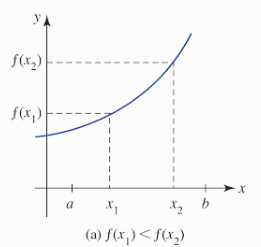 | Figure 1. Increasing curve |
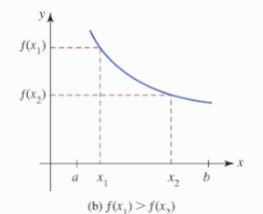 | Figure 2. Decreasing curve |
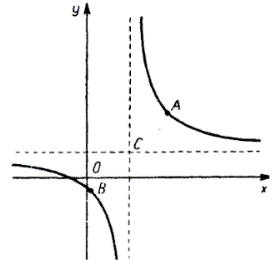 | Figure 3. Example of an homographic function |
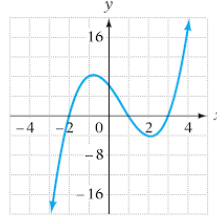 | Figure 4. Example of a polynomial function |
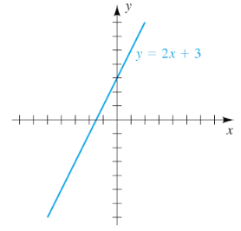 | Figure 5. Example of increasing linear function |
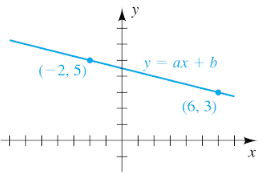 | Figure 6. Example of decreasing linear function |
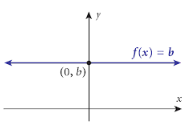 | Figure 7. Example of constant linear function |
5.2. Decreasing of Negative Stimuli and Its Mathematical Expression
- Since the number of negative stimuli decreases over time by the effect of relaxation (Sec. 4.3), we can choose a linear decreasing mathematical function which expresses this reduction and then mathematically express this phenomenon. This choice comes from the fact that a linear function is a simple equation and easy to use.N = ct + dWith,N = number of negative stimuli at time tc < 0 to express decreasing. The greater the value of c, the more rapidly N decreases rapidly (Sec. 5.1.).t : the day of the relaxation practicing periodd : the number of negative stimuli at time zero (before starting practicing relaxation). At t=0, N =dExample: for a person who is much stressed and is not exposed to any positive stimuli
 (Sec. 3), we pose PSS = -6 as an example of his/her stress state before starting practicing relaxation. We pose also d = 4 as an example of the number of negative stimuli that this person faces every day. These negative stimuli could be, for example, work problem, partner conflict, coffee drinking and sleep disorder which represent the 4 stressors (negative stimuli). We give the value -2 to c as an example. N and S will be then as follows:N = -2t + 4Referring to the equation 3 and adding relaxation as a positive stimulus, the value of stress state of this person at the end of the period is:
(Sec. 3), we pose PSS = -6 as an example of his/her stress state before starting practicing relaxation. We pose also d = 4 as an example of the number of negative stimuli that this person faces every day. These negative stimuli could be, for example, work problem, partner conflict, coffee drinking and sleep disorder which represent the 4 stressors (negative stimuli). We give the value -2 to c as an example. N and S will be then as follows:N = -2t + 4Referring to the equation 3 and adding relaxation as a positive stimulus, the value of stress state of this person at the end of the period is: Where,STNi (= -2ti + 4) is the number of negative stimuli faced during a day ti of the period. SNTi is positive and the sign minus (-) expresses the fact that the value of a negative stimulus is negative [1].STPi is the number of positive stimuli received during a day ti. We suppose that this number does not increase during the period and remains at zero.STRi is the number of relaxations considered as a positive stimulus.Supposing that the value (quality) of relaxation stimulus received every day is +1, the variation of the negative stimuli number and the stress state of the person during a period of days are reported on table 1 and Figure 8. PSSi and Si represent the values of the stress state of the person at the beginning of the day i. and at its end respectively.
Where,STNi (= -2ti + 4) is the number of negative stimuli faced during a day ti of the period. SNTi is positive and the sign minus (-) expresses the fact that the value of a negative stimulus is negative [1].STPi is the number of positive stimuli received during a day ti. We suppose that this number does not increase during the period and remains at zero.STRi is the number of relaxations considered as a positive stimulus.Supposing that the value (quality) of relaxation stimulus received every day is +1, the variation of the negative stimuli number and the stress state of the person during a period of days are reported on table 1 and Figure 8. PSSi and Si represent the values of the stress state of the person at the beginning of the day i. and at its end respectively.  | (4) |
|
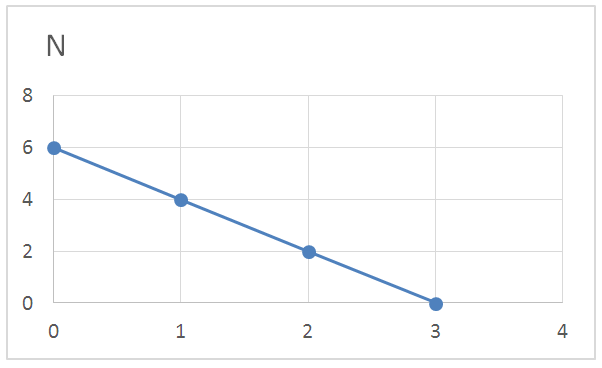 | Figure 8. Negative stimuli decreasing |
5.3. Increasing of Positive Stimuli and Its Mathematical Expression
- Since the number of positive stimuli increases over time (Sec. 4.4.) by the effect of relaxation, we can choose a linear increasing mathematical function which expresses this increasing and then mathematically express this phenomenon. P = at + bWhere,P= number of positive stimuli at time ta > 0 to express increasing. The greater the value of a, the more rapidly P increases rapidly (Sec. 5.1.).t: time of the relaxation practicing periodb = 0, because we suppose that the person was not exposed to any positive stimuli before practicing relaxation. At t=0 (before relaxation), P = 0.Example: for a person who is much stressed and is not exposed to any positive stimuli
 (Sec. 3), we pose PSS = -6 as an example of his/her stress state before starting practicing relaxation. We give the value 0,5 to a as an example. a is much less than c (-2), because we suppose that during the relaxation therapy period, the person requires more time to be able to be exposed to positive stimuli. P and S will be then as follows:P = 0,5 tReferring to the equation 3 and adding relaxation as a positive stimulus, the value of stress state of this person at the end of the period is:
(Sec. 3), we pose PSS = -6 as an example of his/her stress state before starting practicing relaxation. We give the value 0,5 to a as an example. a is much less than c (-2), because we suppose that during the relaxation therapy period, the person requires more time to be able to be exposed to positive stimuli. P and S will be then as follows:P = 0,5 tReferring to the equation 3 and adding relaxation as a positive stimulus, the value of stress state of this person at the end of the period is: Where,STNi (= 0,5t) is the number of negative stimuli received during a day ti of the period. SNTi is positive and the sign minus (-) expresses the fact that the value of a negative stimulus is negative [1]. We suppose that the number of negative stimuli does not decrease during the period and remains at zero.STPi (=0,5ti) is the number of positive stimuli received during a day ti. The number of positive stimuli is positive.STRi is the number of the relaxations considered as a positive stimulus.Supposing that the value (quality) of relaxation stimulus received every day is +1, the variation of the positive stimuli number and the stress state of the person during a period of days are reported on table 2 and Figure 9. PSSi and Si represent the values of the stress state of the person at the beginning of the day ti. and at its end respectively.
Where,STNi (= 0,5t) is the number of negative stimuli received during a day ti of the period. SNTi is positive and the sign minus (-) expresses the fact that the value of a negative stimulus is negative [1]. We suppose that the number of negative stimuli does not decrease during the period and remains at zero.STPi (=0,5ti) is the number of positive stimuli received during a day ti. The number of positive stimuli is positive.STRi is the number of the relaxations considered as a positive stimulus.Supposing that the value (quality) of relaxation stimulus received every day is +1, the variation of the positive stimuli number and the stress state of the person during a period of days are reported on table 2 and Figure 9. PSSi and Si represent the values of the stress state of the person at the beginning of the day ti. and at its end respectively.
|
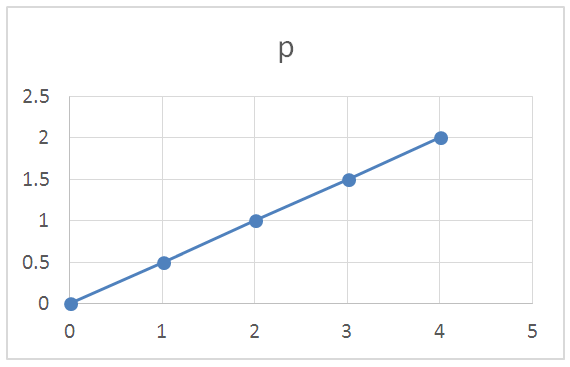 | Figure 9. Positive stimuli increasing |
6. Stress Reduction and Its Mathematical Demonstration
- During a period of n days in which a stressed person practices relaxation, his/her number of negative and positive stimuli decreases and increases respectively. Taking the example of the person used in sections 5.2. and 5.3 and referring to the 2 equations used separately, his/her state of stress at the end of the period is as follows:
 Where,
Where, | (5) |
 (a-c) > 0, because c < 0n = the number of relaxation therapy days
(a-c) > 0, because c < 0n = the number of relaxation therapy days6.1. Demonstration 1
- Let’s divide the period n into 2 sub-periods. One from 1 to m days and the other from (m+1) days to n. During the first m days all (a-c)ti –d are negative. From day (m+1) on, all (a-c)ti –d will be always positive, because (a-c) > 0 [44]. In the example below (Sec 6.3.), m is equal to 1.The first part of the equation 6, which represents the first period, is negative. It is constant, because m does not vary and PSS is already constant. The second part, which represents the second period, increases over time as n increases and it will be always positive. After a period, S will be obligatory positive. Thus, the value of the stress state of the person would be null then positive. A positive value means that the person feels happy after a period of n days of relaxation practice.
 | (6) |
6.2. Demonstration 2
- Instead of dividing the period of relaxation into 2 sub-periods, let’s pose the equation as it was presented (5).
 Referring to section 5.1., (a-c)ti - d can be considered as a linear increasing function, because (a-c) is positive. The value of a linear increasing function becomes positive after n days.Since
Referring to section 5.1., (a-c)ti - d can be considered as a linear increasing function, because (a-c) is positive. The value of a linear increasing function becomes positive after n days.Since  is the sum of linear functions, PSS is constant and
is the sum of linear functions, PSS is constant and  is always positive, then S will be obligatory positive after n days.
is always positive, then S will be obligatory positive after n days.6.3. Example
- PSS = -6STPi = 0,5ti: the number of positive stimuliSTNi = -2ti + 4: the number of negative stimuli(a-c)t –d = (0,5 + 2) t – 4 = 2,5t -4The variation of the positive and negative stimuli numbers and the stress state of the person during a period of n days are reported on table 3 and Figure 10.
|
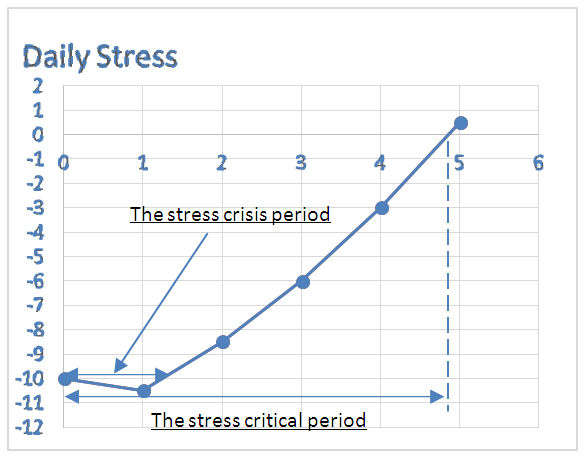 | Figure 10. Daily stress variation |
6.4. The Determination of the Critical Period
- Let’s name Tc as a stress critical period. Tc represents a period of days after which a person who starts practicing relaxation sees his/her stress reducing to zero (Tc = ti when Si=0). In our example, the stress critical period Tc is around 5 days (Table 3) (Figure 10). By using the equation 5, we can determine Tc.
 From this equation and according to Table 3, we can deduce the value Si of stress state at time ti:
From this equation and according to Table 3, we can deduce the value Si of stress state at time ti: | (7) |
 From these inequalities we infer the following:
From these inequalities we infer the following: | (8) |
7. Discussion
- By using linear increasing and decreasing mathematical functions, we found that the value of stress state (S) decreases over time by the effect of relaxation practice. We posed that the person, in our stress situation example, had -6 and 4 as the value of his/her stress state and the number of his/her negative stimuli number respectively before starting to practice relaxation. After around a period of 5 days, his/her value of S became positive (+ 0,5) (Table 3, Figure 10).
7.1. The Variation of the Critical Period
- According to the equation (8), we have the following:- If a, c and STRi remain constants, the critical period Tc increases if the number d increases. Thus, In order to reach more rapidly a neutral state of stress (no stress), the number of negative stimuli to which a person is exposed before doing relaxation has to decrease. This means that when a person is much stressed it will be very difficult for him/her to fight his/her stress. This is consistent with our tri-transactional theory of stress [1].- If d and STRi remain constants, the critical period decreases if the absolute value of c (|c|) or the value of a increases (a>0, c<0). This means that if a person wants to reach rapidly the neutral state of stress, the number of his/her negative stimuli and the number of his/her positive stimuli has to decrease or/and to increase rapidly respectively. - If d, a and c remain constants, the critical period decreases if STRi increases. If the quality of relaxation (duration, number of sessions…) received by a person during the day ti or during a set of days or during the whole period increases, the number of days (Tc) after which he/she could get rid of his negative state of stress decreases rapidly. The higher the quality of relaxation practiced the more rapid we could fight stress.Since the number of negative stimuli d and the quality of relaxation STRi are independents, we could suppose that a and c depend on the relaxation quality. The higher the quality of relaxation, the greater are a and |c|. Practicing relaxation, for example, twice a day is more beneficial than one time [34].
7.2. The Crisis Stress Period
- The person in our example has been very stressed before starting his/her relaxation therapy. In order to fight his stress, i.e to reach the neutral state of stress, he/she needed time. During the first days of the period, we see that his negative state of stress increases before decreasing (Figure 10). There exist then a period, we call the stress crisis period (Figure 10), after witch his/her negative stress stabilizes and starts to decrease (Figure 10). This phenomenon can be explained by the fact that:1) The number of relaxation stimuli STRi is not big enough to eliminate PSS that was negatively great in the beginning and to get rid of the number of negative stimuli that the much stressed person encounters every day;2) The negative state of stress should have increased if the person hadn’t received relaxation therapy. In our example the crisis period is 1 day if the number of positive stimuli increases (Table 2) and 2 if the number of stimuli remains at zero (Table 1). This is consistent with previous researches, stating that stress level could increase across time. According to Neece and al. children of stressed parents who face recurrent and new stressors could have an increased stress levels over time [50]. The determination of the stress crisis period Tcr can be done the same way as for the stress critical period Tc.
 | (9) |
 | (10) |
|
7.3. The Effect of Relaxation Alone
- If we don’t take into account the increasing number of positive stimuli during the relaxation period, i.e. ati = 0, the effect of this therapy alone as a positive stimulus is not sufficient to reduce rapidly the negative value of stress during that period. (Table 1) (Figure 8).
8. Conclusions
- As was hypothesized, we can mathematically demonstrate that relaxation therapy, considered as a positive stimulus in the numerical approach of stress [1], has positive effects on the stress reduction. This mathematical demonstration, using the ktiri-stress equation (S = PSS + ST), proves that the tri-transactional theory of stress [1] could be used as a numerical approach to explain the occurrence of stress and to assess its state value (negative, neutral or positive).If this psycho-mathematical study has shown us that relaxation has positive effect on stress, this could also be applied to other mind-body techniques (meditation,…). This present study and the numerical approach [1] are a proof that we can also introduce mathematics in the psychology field.Future studies could also use other type of increasing and decreasing mathematical functions to do this demonstration.
 Abstract
Abstract Reference
Reference Full-Text PDF
Full-Text PDF Full-text HTML
Full-text HTML